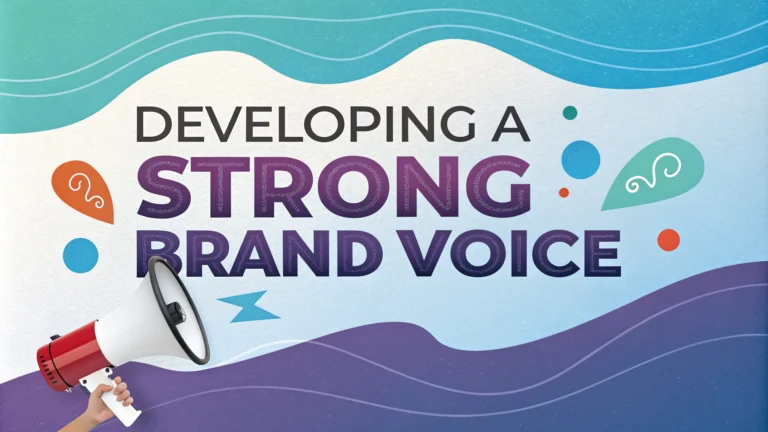A strong brand voice sets your business apart by communicating your unique personality and values consistently across all platforms.
Your brand voice shapes how customers perceive and connect with your company, making it essential for building lasting relationships.
Elements of Brand Voice
- Personality traits
- Tone and language style
- Word choice and vocabulary
- Communication values
Defining Your Brand Voice
Start by listing 3-4 core personality traits that represent your brand identity.
| Brand Type | Voice Characteristics |
|---|---|
| Professional Services | Authoritative, clear, helpful |
| Tech Startups | Innovative, direct, friendly |
| Lifestyle Brands | Casual, inspiring, authentic |
Creating Voice Guidelines
- Document specific examples of appropriate language
- Create a do’s and don’ts list for content creators
- Include sample phrases and terminology
- Define tone variations for different channels
Consistency across all platforms helps build brand recognition and trust.
Practical Tips for Implementation
- Review existing content to identify current voice patterns
- Create templates for common communications
- Train team members on voice guidelines
- Regular audits to maintain consistency
Monitor customer feedback and engagement metrics to refine your brand voice over time.
Common Brand Voice Mistakes
- Inconsistent tone across platforms
- Copying competitors instead of developing unique voice
- Ignoring target audience preferences
- Not adapting to channel-specific requirements
Tools for Brand Voice Development
- Grammarly – Tone and consistency checker
- Hemingway Editor – Clarity improvement tool
- IBM Watson Tone Analyzer – Content tone analysis
Regular voice audits help maintain consistency and identify areas for improvement.
Contact a brand strategist for professional guidance through email: [email protected].
Measuring Brand Voice Success
Track key metrics to evaluate the effectiveness of your brand voice implementation and make data-driven adjustments.
Key Performance Indicators
- Engagement rates on social media
- Customer feedback sentiment
- Brand recognition surveys
- Content performance metrics
- Customer service satisfaction scores
Adapting Voice Across Channels
While maintaining consistency, subtle adjustments help optimize communication for different platforms:
| Channel | Voice Adaptation |
|---|---|
| Social Media | More casual, conversational |
| Website | Professional, informative |
| Email Marketing | Personal, targeted |
Evolution of Brand Voice
Brand voice should evolve with your company’s growth and market changes while maintaining core identity elements.
Triggers for Voice Updates
- Market expansion
- New target audience segments
- Shifting industry trends
- Company repositioning
Conclusion
A well-defined and consistently implemented brand voice creates meaningful connections with audiences and differentiates your business in the marketplace. Regular monitoring, measurement, and adaptation ensure your brand voice remains effective and relevant.
Success in brand voice development requires ongoing commitment to:
- Consistent implementation across all touchpoints
- Regular training and team alignment
- Performance measurement and optimization
- Strategic evolution with business growth
FAQs
1. What exactly is a brand voice and why is it important for logo design?
A brand voice is the distinct personality and tone used in all brand communications. In logo design, it influences visual elements by ensuring the logo’s style, colors, and overall aesthetic align with how the brand wants to be perceived by its audience.
2. How do colors affect brand voice in logo design?
Colors evoke specific emotions and associations – blue suggests trust and professionalism, red conveys energy and passion, green represents growth and nature. Choosing colors that match your brand voice helps reinforce your brand’s personality and message.
3. Should my logo design change if my brand voice evolves?
While logos should have longevity, subtle updates may be necessary if your brand voice significantly shifts. Many successful brands like Apple, Pepsi, and Google have evolved their logos over time while maintaining core recognizable elements.
4. What typography choices best reflect different brand voices?
Serif fonts convey tradition and reliability, sans-serif suggests modernity and simplicity, script fonts communicate elegance or creativity, while bold typefaces project strength and confidence.
5. How can symbols and icons in logos reinforce brand voice?
Symbols should align with your brand voice – geometric shapes suggest stability and professionalism, organic shapes convey friendliness and approachability, while abstract symbols can communicate innovation and creativity.
6. What’s the relationship between brand voice and logo simplicity?
A strong brand voice often benefits from simple logo design, as simplicity ensures better recognition and versatility. Companies like Nike and Apple use minimal designs that powerfully communicate their brand voice.
7. How do different industries influence brand voice in logo design?
Industry standards often influence logo design – tech companies often use clean, modern designs, while children’s brands typically use playful, colorful elements. However, your brand voice can help differentiate you within your industry.
8. Can a logo design incorporate multiple brand voice characteristics?
Yes, logos can balance different aspects of brand voice – for example, combining professional elements with creative touches, or merging traditional with modern elements, as long as it remains cohesive.
9. How important is consistency between brand voice and logo design?
Consistency is crucial – your logo should visually represent the same personality that your brand voice conveys in words. Misalignment between visual identity and brand voice can confuse customers and weaken brand recognition.
10. What are the key elements to test when ensuring logo design matches brand voice?
Test scalability, color variations, audience response, cultural implications, and how well the logo communicates your core brand values. Consider gathering feedback from your target audience to verify alignment with intended brand voice.







